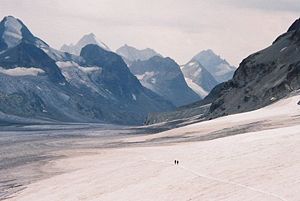Translations:AY Honors/Mountain leadership skills/11/en
Snow slopes
Snow slopes are very common, and usually easy to ascend. At the foot of a snow or ice slope is generally a big crevasse, called a bergschrund, where the final slope of the mountain rises from a snow-field or glacier. Such bergschrunds are generally too wide to be stepped across, and must be crossed by a snow bridge, which needs careful testing and a painstaking use of the rope. A steep snow slope in bad condition may be dangerous, as the whole body of snow may start as an avalanche. Such slopes are less dangerous if ascended directly, rather than obliquely, for an oblique or horizontal track cuts them across and facilitates movement of the mass. New snow lying on ice is especially dangerous. Experience is needed for deciding on the advisability of advancing over snow in doubtful condition. Snow on rocks is usually rotten unless it is thick; snow on snow is likely to be sound. A day or two of fine weather will usually bring new snow into sound condition. Snow cannot lie at a very steep angle, though it often deceives the eye as to its slope. Snow slopes seldom exceed 40°. Ice slopes may be much steeper. Snow slopes in early morning are usually hard and safe, but the same in the afternoon are quite soft and possibly dangerous; hence the advantage of an early start.

